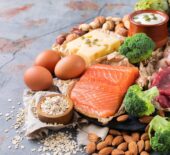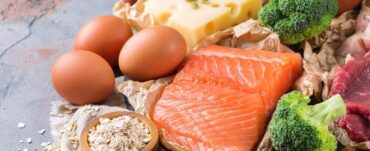Omega-3 fat is an essential fat, meaning you need to include it in your diet for your body to function optimally. This polyunsaturated fat is prevalent in sufficient amounts and in the type of the body likes to use in seafood, particularly fatty fish. This is why it is recommended to include seafood two to three times a week with a serve being 100g of cooked seafood. For athletes, the role of this essential fat may be needed at a level beyond this general health guidelines.
Recommendations from the International Olympic Conference have made recommendations based on the current research that athletes may need up to four times the amount of omega-3 fat than the recommendations made for the general population. 500mg of EPA and DHA which is equal to the two to three serves of seafood each week is the amount recommended for the general population. Athletes may need around 2000mg or eight to ten serves of seafood each week.
Omega-3 fat when consumed from seafood is made up of docosahexaenoic acid (DHA) and Eicosapentaenoic acid (EPA). These two omega-3 acids are the most easily absorbed by your body. In comparison to plant-based sources which are made up of alpha linolenic acid (ALA) where only about 1-7% is converted to the usable form of omega-3 fat EPA and DHA in your body.
Omega-3 fat, specifically DHA, is the main type of fat needed by your brain, skin and the retina of your eye. Omega-3 fat as a polyunsaturated fat also promotes healthy cholesterol levels and heart health.
For athletes the anti-inflammatory properties of omega-3 fat become especially important for recovery. Research has also linked omega-3 fat to reduced delayed onset muscle soreness effects. The ability of the muscles to grow called muscle protein synthesis as well as muscle maintaince may also be improved when omega-3 fat is included in adequate amounts in the diet.
The importance of omega-3 fat for endurance athletes is even more important as this essential fat helps to dilate the blood vessels, improving blood flow and oxygen available to the muscles when exercising.
Take home message: Omega-3 fat can play a huge role in improving your performance and optimizing your recovery. If you are an athlete and not meeting the recommended servings of seafood recommended each week for the general population this is the best place to start. Before increasing the amount of seafood above these general population recommendations seek individualized support from an Accredited Practicing Dietitian who can make sure your diet is personalized to your individual needs and goals.
References:
- Maughan, R. J., Burke, L. M., Dvorak, J., Larson-Meyer, D. E., Peeling, P., Phillips, S. M., Rawson, E. S., Walsh, N. P., Garthe, I., Geyer, H., Meeusen, R., van Loon, L., Shirreffs, S. M., Spriet, L. L., Stuart, M., Vernec, A., Currell, K., Ali, V. M., Budgett, R. G., Ljungqvist, A., Mountjoy, M., Pitsiladis, Y., Soligard, T., Erdener, U., & Engebretsen, L. (2018). IOC Consensus Statement: Dietary Supplements and the High-Performance Athlete, International Journal of Sport Nutrition and Exercise Metabolism, 28(2), 104-125. Retrieved Jul 30, 2021, from https://journals.humankinetics.com/view/journals/ijsnem/28/2/article-p104.xml
- Danielle Swanson, Robert Block, Shaker A. Mousa, Omega-3 Fatty Acids EPA and DHA: Health Benefits Throughout Life, Advances in Nutrition, Volume 3, Issue 1, January 2012, Pages 1–7, https://doi.org/10.3945/an.111.000893








